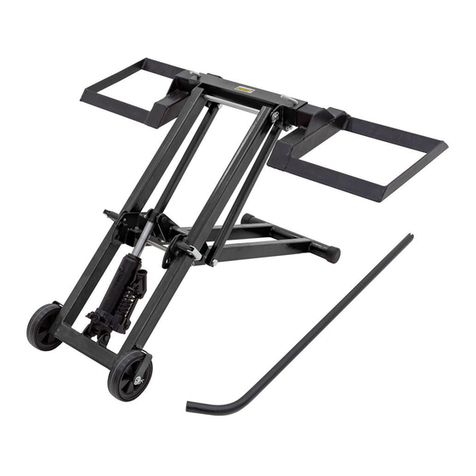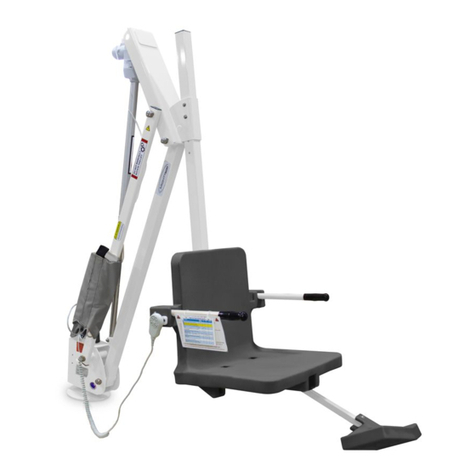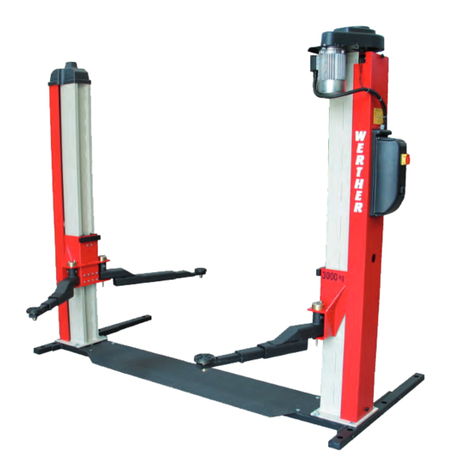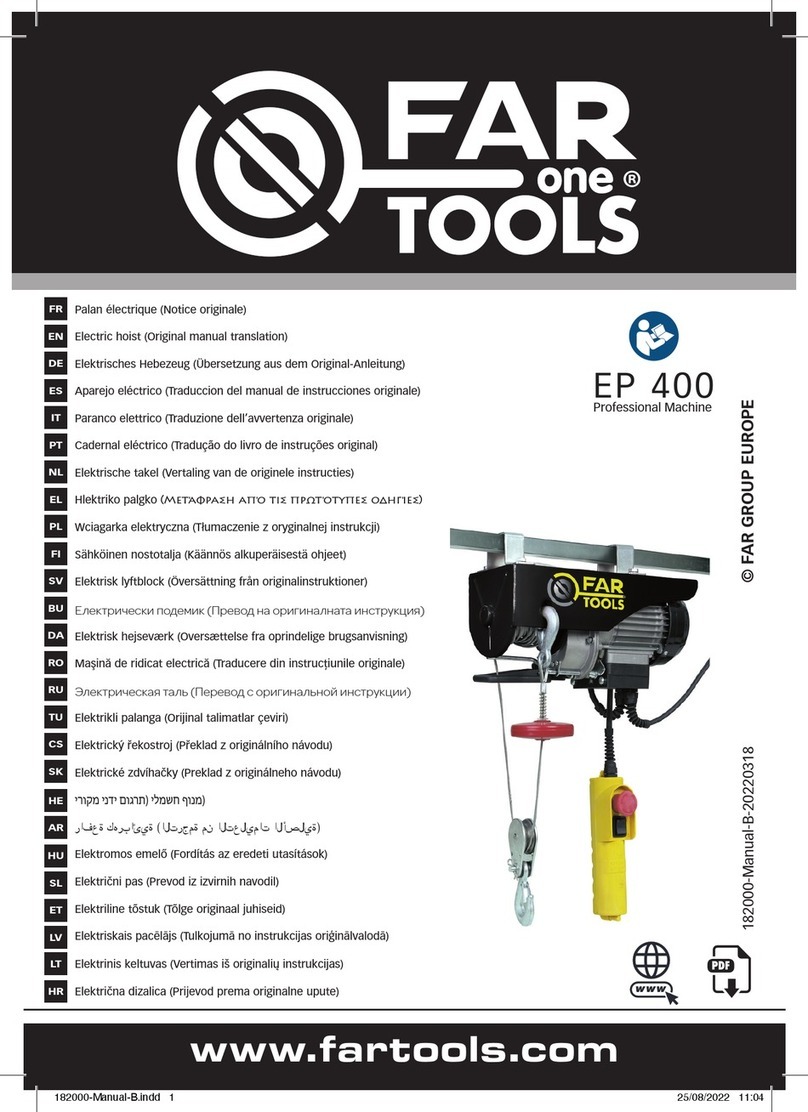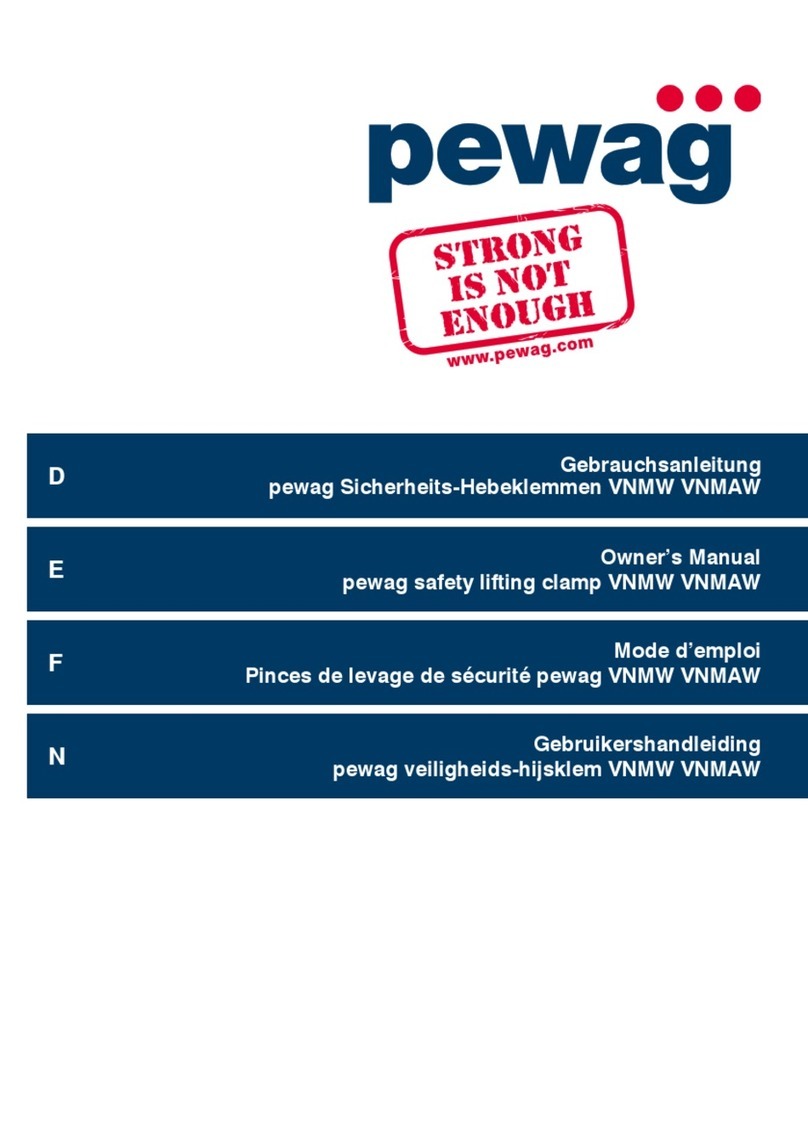ELEPHANT LIFTING PRODUCTS Grippa User manual

PUSH & GEARED TROLLEY MANUAL
Elephant Lifting Products Trolley Manual


1 | Page
Contents
1 Personnel Competence .................................................. 2
2 Preface ............................................................................ 2
3 Safety Information .......................................................... 3
3.1 Danger, Warning, Caution and Notice ................... 4
3.2 Safety Summary ..................................................... 4
4 Identification .................................................................. 5
5 Main Components .......................................................... 5
6 Intended Use .................................................................. 5
7 Safe Operating Instructions ............................................ 6
8 Installation ...................................................................... 6
9 Clearances ...................................................................... 7
10 Operating Conditions ..................................................... 7
10.1 Initial Operating Checks ......................................... 7
11 Lubrication ...................................................................... 7
11.1 Geared Trolley Wheels .......................................... 7
12 Safe Transportation ........................................................ 7
13 Storage ........................................................................... 8
14 Inspection ....................................................................... 8
14.1 Frequent Inspection ............................................... 8
14.2 Periodic Inspection ................................................ 8
14.3 Records and Reports .............................................. 9
15 Troubleshooting ............................................................. 9
16 Maintenance .................................................................. 9
16.1 Cleaning and Care ................................................ 10
16.2 Spare Parts ........................................................... 10
17 Hand Chain Adjustment or Replacement ..................... 10
17.1 To Replace Hand Chain ........................................ 10
17.2 To Adjust Chain Length ........................................ 10
18 Technical Data .............................................................. 11
This operation manual edition 05/2017 covers
Elephant
Lifting Products Geared and Push Trolleys:
It must be read carefully and in its entirety before
operating any trolley.
Serial No.
Please enter the Serial No. of your Elephant Lifting
Products trolley here.
2

2 | Page
This operation manual covers the following Elephant
Lifting Products Trolleys:
Manual trolleys
Geared trolleys
THIS MANUAL MUST BE READ CAREFULLY
BEFORE OPERATING OR REPAIRING THESE
PRODUCTS.
This manual contains important safety, operation,
installation, inspection, maintenance and repair
information of Elephant Lifting Products trolleys for
proper and efficient operation. Make this manual
available to all persons responsible for the
operation, installation, inspection, maintenance and
repair of these products. Even if you feel you are
familiar with this or similar equipment, you should
read this manual before operating the product.
•Do not use these trolleys for lifting, supporting, or
transporting people and lifting or supporting loads
over people.
Always operate, install, inspect, maintain, repair and use
these trolleys in accordance with South African Bureau of
Standards Specification number SANS1824:2003 for a
geared or manually driven trolley.
Testing of trolleys must only be carried out by the
competent personnel contemplated in SANS1824:2003
and American Society of Mechanical Engineers (ASME)
standard B30.17-2015.
For Trolleys used outside of South Africa:
It is the responsibility of the owner/user to construct,
operate, install, inspect, test, maintain, repair and use the
trolleys in accordance with ASME B30.17-2015, “Safety
Standard for Cranes and Monorails (with Underhung
Trolleys)” and as well as with Occupational Safety and
Health Administration (OSHA) Regulations.
If the trolley is installed as part of a total lifting system,
such as an overhead crane or monorail, it is also the
responsibility of the owner/user to comply with the
applicable ASME B30 Volume that addresses that type of
equipment.
It is the responsibility of the owner/user to have all
personnel that will construct, operate, install, inspect, test,
maintain, repair and use the trolleys to read the contents
of this manual and applicable portions of ASME B30.17-
2015, “Safety Standard for Cranes and Monorails (with
underhung Trolleys)” and as well as being familiar with
OSHA Regulations.
If the trolley owner/user requires additional information,
or if any information in this manual is not clear, contact
Elephant Lifting Products or the distributor of the
trolley(s). Do not construct, operate, install, inspect, test,
maintain and repair these trolleys unless this information
is fully understood.
A regular schedule of inspection of the trolley(s) in
accordance with the requirements of ASME B30.17-2015,
should be established and records maintained.
The ASME B30 Standard is intended to:
(a) Prevent or minimize injury to workers and
protects property by prescribing safety
requirements.
(b) Guide governments and other regulatory bodies
in the development, promulgation and
enforcement of appropriate safety directives.
1 Personnel Competence
According to ASME B30 Standard, persons performing
construction, operation, installation, inspection, testing,
maintenance, repairing and using Elephant Lifting Products
trolleys shall through education, training, experience,
skills and physical fitness, as necessary, be capable of
performing the functions as determined by the
employer or employer’s representative.
2 Preface
Elephant Lifting Products warrants to the user its trolleys,
and other products to be free from defects in material
and workmanship for a period of one year from the date
of purchase.
Elephant Lifting Products will at its discretion repair
without cost (including parts and labour charges) to the
user for any product found to be defective. Elephant Lifting
Products will replace such product(s) and refund the
purchase price less a reasonable allowance for
handling in exchange for the defective product(s). All
repaired and replaced product(s) are warranted for the
remainder of the original warranty period.
If any product proves defective within its original one year
warranty period, it must be returned to Elephant Lifting
Products with proof of purchase and the original
test certificate. This warranty does not apply to products
which Elephant Lifting Products has determined to have
been misused, abused and improperly maintained by the
user or where the malfunction or defect was attributed
by the use of non-genuine Elephant Lifting Products parts.
Elephant Lifting Products makes no other warranty and
its maximum liability is limited to the purchase price of the
product and in no event, will Elephant Lifting Products be
liable for any consequential, indirect, incidental or special
damages of any nature arising from the use of the product
whether based on contract or otherwise.
It is Elephant Lifting Products policy to promote safety of
all persons and equipment in the workplace. All equipment
manufactured is thoroughly checked, packed and
inspected before dispatch. Any loss or damage which
3

3 | Page
occurs during shipment while en-route must be reported to
Elephant Lifting Products immediately. Should any item be
delivered to you in apparent good condition, but upon
opening the container, loss or damage has taken place
while in transit; notify Elephant Lifting Products immediately.
Should any items be delivered back to Elephant Lifting
Products all transport costs will be on the account of the
user.
These instructions were prepared by Elephant Lifting
Products to provide agents, fitters, and company
personnel with information required for the purpose of
construction, operation, installation, inspection,
maintenance, repair and the use of its trolleys.
No responsibility for failure of equipment due to
manufacturing procedure will be assumed if these
instructions are not carried out. Only original Elephant
Lifting Products supplied spares are to be used in all repairs.
3 Safety Information
This manual will refer to existing legal requirements and
engineering practices as known when this document was
written. Should any such legislation or practices change or
be “enlarged” upon then due consideration must be
taken. Various standards have been used to assist in
compiling this document and will be listed where
applicable.
According to ASME B30 Standard the use of trolleys is
subject to hazards that cannot be overcome by
mechanical means but only by the exercise of
intelligence, care and common sense.
It is therefore essential that personnel involved in the
construction, operation, installation, inspection, testing,
maintenance, repairing and using Elephant Lifting Products
trolleys must be careful, competent, trained, physically
and mentally qualified in the safe operation of this
equipment and handling of loads.
Serious hazards include but not limited to, overloading,
improper or inadequate maintenance, dropping or
slipping of the load caused by improper hitching or
slinging, obstructing the free passage of the load and
using equipment for a purpose for which it was not
intended or designed.
The above can lead to fatal consequences. Operators of
Elephant Lifting Products trolleys are also under obligation to
ensure safe and hazard-free operation. This can be
achieved through the following measures:
Keep the operation manuals available at the trolley
operating site,
Performing regular training,
Performing regular inspections (at least once
annually),
Implement an inspection log and make regular
entries,
And regularly check personnel for safety and hazard
awareness during work.
Elephant Lifting Products fully realizes the importance
of proper design factors, minimum and maximum sizes
and other limiting dimensions of the trolley and its
fastenings, chains, sprockets and similar parts all of
which are designed with safety in mind.
The various conditions of the equipment or material can
vary depending on the environment they are used in
which may cause corrosion or wear and any other
variables that may arise in each individual application. It
is in the light of this that the trolley(s) must be maintained
and repaired under the supervision of a competent
person:
(a) Who is qualified by virtue of his knowledge, training,
skills and experience to organize the work and its
performance;
(b) Who is familiar with the legal requirements which
apply to the work to be performed;
(c) Who has been trained to recognize any potential or
actual danger to health and safety in the performance
of the work.
The instructions given in this manual must be interpreted
accordingly and sound judgment used in determining their
application. It is intended to help the operator to become
familiar with Elephant Lifting Products trolleys and
how to use them properly. Observance of the
manual helps to avoid hazardous situations, to
reduce repair costs and downtimes and to ensure
the specified service life of the Elephant Lifting Products
trolleys.
•Always keep this manual readily available at the
location where the Elephant Lifting Products trolley(s)
is or are being used.
•All persons charged with constructing, testing,
operating, installing, inspecting, maintaining,
repairing and using Elephant Lifting Products trolleys
must read and follow all the instructions in this
manual.
4

3.1 Danger, Warning, Caution and Notice
Throughout this manual there are steps and procedures
which, if not followed, may result in an injury. The
following signal words are used to identify the level of
potential hazard.
Danger is used to indicate the presence of hazard which
will cause severe injury, death or substantial property
damage if the warning is ignored.
Warning is used to indicate the presence of a hazard
which can cause severe injury, death, or substantial
property damage if the warning is ignored.
Caution is used to indicate the presence of a hazard
which will or can cause minor injury or property damage
if the warning is ignored.
Notice is used to notify people performing operation,
installation, inspection and maintenance information
which are important but not hazard-related.
3.2 Safety Summary
1 Do not use these trolleys or any equipment attached
to it for lifting, supporting or transporting people and
lifting or supporting loads over people.
•Elephant Lifting Products trolleys are designed
to provide a MINIMUM of 5 to 1 safety factor. It is
the responsibility of the customer to ensure that the
structure to which a trolley is attached and any load
attaching device(s) used in conjunction with a
trolley(s) can handle the static and dynamic load(s)
when the trolley is lifting
and lowering the rated load. If in doubt, consult a
registered professional structural engineer.
•If a hoist is to be used in conjunction with the
trolley, ensure that a hoist having a rated
capacity equal to or less than the capacity of the
trolley is specified.
2 Lifting equipment is subject to different regulations in
each country. These regulations may not be
specified in this manual. Whenever a conflict arises
between the contents of this manual and any other
applicable legislation, standard or procedure, the
more stringent of the two must be applied.
The Occupational Health and Safety Act and Mine Health
and Safety Act and other recognized safety sources make
a common point: Employees who work near cranes or
assist in hooking on and arranging a load(s) should be
instructed to keep out from under the load.
From a safety standpoint, one factor is paramount,
conduct all lifting operations in such a manner that if there
were an equipment failure, no personnel would be injured.
This means keep out from under a raised load and keep
out of the intended path of any load.
Elephant Lifting Products Trolleys are manufactured in
accordance with the latest ISO9001 standards. The
Occupational Safety and Health Act of 1993, section 10
states:
1. Any person who designs, manufactures, imports,
sells or supplies any article for use at work shall
ensure, as far as is reasonably practicable, that the
article is safe and without risks to health when
properly used. It must comply with all prescribed
requirements.
2. Any person who erects or installs any article for use
at work on or in any premises shall ensure, as far as
is reasonably practicable, that nothing about the way
it is erected or installed makes it unsafe or creates a
risk to health when properly used.
3. Any person who manufactures, imports, sells or
supplies any substance for use at work shall:
(a) Ensure, as far as is reasonably practicable, that
the substance is safe and without risks to health
when properly used; and
(b) Take necessary steps to ensure that information
is available about the use of the substance, the
associated risks to health and safety and the
procedures to be followed in the case of an
accident involving such substance.
4. Where a person designs, manufactures, imports,
sells, or supplies an article or substance for or to
another person, and that other person, and that other
person undertakes in writing to take specified steps
WARNING
NOTICE
CAUTION
WARNING
NOTICE
DANGER
5

5 | Page
sufficient to ensure, as far as is reasonable
practicable, that the article or substance will comply
with all prescribed requirements and will be safe and
without risks to health when properly used. The
undertaking shall have the effect of relieving the first
mentioned person from the duty imposed upon him
by this section to such an extent as may be
reasonable having regard to the terms of the
undertaking.
It is the owner’s and user’s responsibility to determine the
suitability of a product for any particular use. It is
recommended that all applicable industry, trade
association and legislation are checked. Read all
operation instructions and warnings before operation.
It is extremely important that fitters and operators are
familiar with the servicing procedures of these products,
or similar products and are physically capable of
conducting the procedures. These personnel shall have a
general working knowledge that includes:
(a) Safe use and application of fitter’s common hand
tools as well as special or recommended tools.
(b) Safety procedures, precautions and work habits
established by accepted industry standards.
Elephant Lifting Products cannot know of, nor provide
all the procedures by which product operations or repairs
may be conducted and the hazards and/or results of
each method. If operation or maintenance
procedures not specifically recommended by the
manufacturer are conducted, it must be ensured that
product safety is not endangered by the actions
taken. If unsure of an operation or maintenance
procedure, personnel should place the product in a
safe condition and contact supervisors and/or the factory
for technical assistance.
4 Identification
The nameplate mounted on the side plate identifies the
type of Elephant Lifting Products trolley, rated load,
manufacturer’s name (Elephant Lifting Products) and the
model or serial number.
If you have any questions concerning the operation of
Elephant Lifting Products trolleys which are not
addressed in this operation manual, please contact
us at the following address:
Elephant Lifting Products
38381 N Robert Wilson Rd
Gonzales, Louisiana, 70737
Phone (888) 844-6113
Fax (225) 644-6695
e-mail: [email protected]
5 Main Components
Elephant Lifting Products trolleys consist of the
following main components:
1 Side plates
2 Rolling wheels
3 Distance spacers
4 Crosshead
5 Reel chain drive (for running geared wheels)
Exception: no drive with push trolleys.
6 Intended Use
Elephant Lifting Products trolleys are intended to be
used exclusively for lifting, lowering loads and for their
horizontal movement of the load above floor.
Elephant Lifting Products air hoists can be suspended
or built into trolleys.
Any other use outside these stipulations is deemed to be
impermissible. For applications requiring this type of use
please consider the Elephant Lifting Products range of
winches and the Elephant Lifting Products range of
hoists. Elephant Lifting Products cannot be held liable
for any damage resulting from incorrect usage. The
entire risk is borne by the operator.
The following situations, among others, are regarded as
improper use:
•Exceeding the permitted load-carrying capacity
•Oblique pulling of loads
•Sliding loading
•Dropping a trolley
•Detaching, dragging or pulling of loads
•Catching of falling loads
•Carrying people
•Switching to the opposite direction with load in motion
•Operation reaching of the end stop
Intended use also includes observance of the operation
manual and compliance with the inspection and
maintenance conditions according to ASME B30
Standards.
6

6 | Page
7 Safe Operating Instructions
1. Before each use or shift, the operator should inspect
the trolley for distortion, wear and damage.
2. If inspection indicates that a trolley is damaged, it
should never be used. Replace any item indicating
damage, distortion and/or excessive wear.
3. To avoid an unbalanced load which may damage the
trolley, operate the trolley when the load or hoist (if a
hoist is used in conjunction with the trolley) is
centered under the trolley. Position the hanger shaft
at the centerline of the trolley and beam using
properly installed spacer washers. Do not “side pull”.
4. If a hoist is to be used in conjunction with the trolley,
ensure that a hoist having a rated capacity equal or
less than the capacity of the trolley is specified.
5. Do not use these trolleys for lifting, transporting
people or supporting loads over people. Make sure
people or any obstruction are clear of the load path
before traversing the load and trolley.
6. If multiple trolleys are used together at the same time,
avoid collision or bumping of trolleys and do not ram
trolleys into the end stops. Improper and careless
operation can result in a hazardous condition for
operator and load.
7. Ensure stops are securely installed at both ends of
the beam prior to using trolley.
8. Ensure that stops are installed to prevent the trolley
from running off either of the open ends of the beam
track when the trolley is being installed over the open
end of the beam.
9. On a hand-operated trolley, the stops should engage
parts of the trolley other than a wheel. If a stop
engages the tread of the wheel, its height shall be no
less than the radius of the wheel.
10. Do not join a hand chain by inserting a bolt between
links as this may cause jamming of a hand chain with
the hand wheel sprocket.
11. Do not swing a suspended load.
12. Ensure that trolley wheels’ ride on the top surface of
the lower flange of the beam.
13. Install manual chain hoists so that hoist hand chain is
on opposite side of trolley hand chain.
14. When operating the trolley, keep the load as close to
the floor as practical to make people aware and keep
clear of any load the trolley is supporting.
8 Installation
The installation of the Elephant Lifting Products
trolleys shall be in accordance with the qualified
persons recommendations described above “Personnel
Competence” on page 2.
Adjust trolley width before installation. Refer to Figure 1
below along with instructions to position spacer washers
for measured beam flange width (W).
Figure 1: Push Trolley
Instructions:
1. Measure the beam width (W) and add 2-4mm to this
amount for clearance between the wheel flanges to
allow 1 to 2 mm of clearance per side (“A” in the
figure);
2. Remove the locknuts from the crosshead and adjust
the width of the trolley by shifting the spacers
accordingly. There are two different thicknesses of
spacers that allow for adjustment in 1mm increments.
Ensure that the amount of spacers on either side of
the crosshead are the same. Spacers not used
between the side plates should be fitted to the shaft
between the side plate and the lock nut. Ensure that
the suspension plate (if fitted) or the groove in the
crosshead is central to the side plates;
3. Fully tighten the locknuts and re-check the clearance
between the wheel flange and the beam.
Upon completion of installation, perform initial operating
checks, Section 10.1 and ensure familiarity with “Safe
Operating Instructions”, Section 7.
NOTE: Rounded wheel tread is suitable for taper and
parallel flanged beams.
DANGER
7

7 | Page
9 Clearances
Under all operating conditions, clearances between
beams, trolleys operating at various levels and potential
obstructions, shall be maintained.
Where passageways or walkaways are provided on
the structure supporting the trolleys, obstructions
shall not be placed so that personnel will be
jeopardized by movements of the trolleys.
Clearances shall be provided at the curves of the beam
to allow for the swing of the load when the trolley is
negotiating the curve. The amount of clearance shall be
determined by considering the size, weight and speed of
the trolley and track curve radius.
10 Operating Conditions
The four most important aspects of trolley operation
are:
1. Follow all safety instructions when operating the
trolley.
2. Ensure that only people instructed in safety and
operation of these products operate the trolley.
3. Inspect each trolley on a regular basis and scheduled
a maintenance program.
4. Always ensure that the weight of the load and rated
capacity of a hoist (if it is to be used in conjunction
with the trolley) are equal or less than the capacity of
the trolley assembly. Do not overload.
10.1 Initial Operating Checks
1. Upon completion of trolley installation, ensure the
side plates are parallel to the beam.
2. If a hoist is used in conjunction with the trolley ensure
that the hoist and load are centered below the trolley
and beam.
3. Lift a load equal to or less than the rated capacities of
either the trolley or hoist a few centimeters or inches
off the floor. This is to ensure that all parts of the
trolley are in working order. If parts of the trolley are
dropped, they can cause severe injury or damage.
4. Ensure that the rail stops are securely installed.
5. Operate the trolley along the entire length of the
beam.
6. Inspect trolley performance when raising, moving and
lowering test load(s). Trolley must operate smoothly
prior to being placed in service.
11 Lubrication
Trolley wheels are equipped with sealed bearing which
require no lubrication.
11.1 Geared Trolley Wheels
Trolleys shall be stationary while lubricants are being
applied. Lubricate exposed trolley drive pinion and wheels
teeth with grease as often as necessary to keep the teeth
liberally covered.
If the grease becomes contaminated with dirt or other
abrasive material, clean off old grease and apply new
grease. For temperature -29o to 10o C (-20o to 50o F) use
M2 EP 1 grease or equivalent grease. For temperature -
1o to 49
o C (-30o to 120o F) use M2 EP 2 grease or
equivalent grease.
•When greasing pinion and geared wheels make
sure excess grease is removed from trolley
wheels riding surface and track of the beam.
•Failure to keep beam track and wheel contact
surface clean affect the safe operation of the
trolley.
12 Safe Transportation
If you wish to transport your Elephant Lifting Products
trolleys to another site or for inspection, please observe
the following points:
1. Dismounting:
a) Make sure there is no load attached to the
trolley;
b) Attach the trolley load hook or suspension
plate to the chain hoist or other means of
lifting;
c) Remove beam or rail stops and slide the
trolley over the edge of the beam;
d) Set the entire trolley down carefully, do not
allow it to drop.
2. Disassembly:
a) Remove the crosshead from the side plates;
Note: Only necessary for geared trolleys.
b) Remove the chain from the hand wheel;
c) Remove the hand wheel assembly from the
geared side plate assembly.
CAUTION
WARNING
DANGER
8

8 | Page
Disassembling a trolley from the beam by separating the
slide plate is extremely dangerous and this operation
should be carried out by the trained or competent
personnel contemplated in SANS1824:2003 and
American Society of Mechanical Engineers (ASME)
standard B30.17-2015.
13 Storage
Store the trolley in a clean, dry place indoors. If lengthy
storage is required, lubricate wheels and place entire
unit in a suitable storage container. Store the product
away from heat and steam. Never allow it to rest for
lengthy periods of time on concrete or ash floors as the
lime sulfur and ash can cause corrosion.
14 Inspection
All inspections shall be performed by designated
personnel in accordance with the Elephant
Lifting Products recommendations and with the
requirements of ASME B30 Volume.
Any deficiency revealed through inspection must be
reported to an appointed or qualified person. A
determination must be made as to whether a more
detailed inspection is required or a deficiency constitutes
a safety hazard to continued operation. Such deficiency
shall be corrected before resuming operation of the
trolley. The results of the inspection must be recorded in
the inspection log.
Careful inspection on a regular basis will reveal potentially
dangerous conditions or evidence of malfunction while
still in the preliminary stages, allowing corrective actions
to be taken before the condition becomes dangerous.
Elephant Lifting Products recommends two types of
inspection:
a) The frequent inspection performed by the operator as
pre-work inspection.
b) The periodic inspections performed by personnel
trained in the operation and repair of these trolleys.
14.1 Frequent Inspection
Trolleys that are in continuous service, inspection should
be made at the beginning of each shift or before the trolley
is first used during each shift.
Elephant Lifting Products trolleys shall be
inspected at intervals depending on severity of
usage, as follows:
NORMAL HEAVY SERVERE
Monthly Weakly to Monthly Daily to Weekly
The following items shall be inspected:
1. Operating mechanisms of the trolley and hand chain
drive wheel for proper operation and adjustment.
Operate the trolley so that it travels 1 metre (3 feet)
along the beam. Inspect for visual signs or abnormal
noises such as but not limited to, squeaking, grinding
and grating which could indicate a problem. Do not
operate the trolley until all problems have been fixed.
2. Inspect trolley load hooks if used in accordance with
ASME B30.10 - 2015 Standard.
Trolleys that have been idle for a period of 1 month or
more but less than 1 year shall be inspected in
accordance with frequent inspection before being placed
into service.
14.2 Periodic Inspection
Frequency of periodic inspection depends on the severity
of trolley usage, as follows:
NORMAL HEAVY SERVERE
Yearly Biannually Quarterly
•Please note the requirements of the Occupational
Health and Safety Act of South Africa (Act 85 of
1993), Driven Machinery (Regulation 18), Lifting
Machines and Lifting Tackle regarding the
examination and testing of lifting machines and lifting
tackle.
Disassembly may be required for HEAVY or SEVERE
usage. Keep accumulative written test records of dated
and signed periodic inspections to provide a basis for
continuing evaluation. Records should be kept available.
Inspection of all the items in “Frequent Inspection” must
be conducted and also the following items shall be
inspected:
1. Fasteners
Check cap screws, retainer rings, pins and nuts. Replace
if missing or damaged and tighten if loose.
2. All Components
Inspect for wear, damage, distortion, deformation and
cleanliness.
If external evidence indicates the need, disassemble.
Check gears, shafts, bearings, wheels, load sheaves and
side plates. Replace worn or damaged parts. Clean,
lubricate and reassemble.
3. Drive Chain Hand Wheel
Check for damage or excessive wear of chain drive
sprockets and excessive chain stretch or distortion.
Replace if necessary. Observe the action of the hand
chain feeding through the hand chain drive.
Do not operate a trolley unless the hand chain feeds
through the hand chain drive smoothly and without
NOTICE
9

9 | Page
irregular sounds or other evidence of jamming, wedging
or malfunctioning.
4. Supporting Structure.
Check the supporting structure for distortion, excessive
wear and continued ability to support the load.
5. Trolley
Check that the trolley wheels run and track the beam
properly and that the clearance between the beam and
trolley wheel flanges is 1 to 2 mm maximum per side.
Check that wheels, bearings shafts, gears or rollers are
not excessively worn, cracked or distorted and inspect the
side plates for opening due to bending. Do not operate
the trolley until any problems have been identified and
fixed.
6. Nameplate.
Check for presence and legibility. Replace if necessary.
Trolleys that has been idle for a period of 1 year or more
shall be inspected in accordance with periodic inspection
before being placed into service.
14.3 Records and Reports
An inspection record should be maintained for each
trolley, listing all points requiring periodic inspection. A
written report should be made monthly on the condition of
the critical parts (e.g. wheels, bearings, side plates and
hanger shaft) of each trolley. These reports should be
dated, signed by each person who performed the
inspection, and kept on file where they are readily
available to the authorized personnel.
15 Troubleshooting
This section provides the information necessary for
troubleshooting the Elephant Lifting Products
Trolleys. The troubleshooting guide provides a
general outline of problems which could be
experienced with normal use of the trolley. Table 1 lists
the symptom, the possible cause, and the possible
remedy for the trouble being experienced.
Table 1: Troubleshooting
16 Maintenance
General maintenance should be performed in accordance
with the requirements of ASME B30 Volume and the
conditions and practices of a particular workplace.
Elephant Lifting Products trolleys are extremely robust
and require little maintenance. They are suitable for
use in explosion-hazardous areas as well as in
areas with increased concentrations of soot and dust,
high humidity and at ambient temperatures of – 20° C
up to approx. + 70° C if they are not heated above
this level due to external influences. The thermal
endurance of chains and hooks is up to + 150° C.
In order for the trolleys to operate safely and reliably over
a period of many years, compliance with maintenance
and inspection intervals is of immense importance. If the
trolley is being operated in a harsh environment that leads
to accelerated wear, then the maintenance intervals
should be reduced.
•Never perform maintenance on the trolley while it is
supporting a load.
•After performing any maintenance on the trolley, test
trolley as described in the “Safe Operating
Instructions”, Section 7, before returning trolley to
service.
SYMPTOM CAUSE REMEDY
Geared
Trolley
cannot be
moved
Hand chain
drive is
stuck or
pinion is
stuck
Repair the chain drive
or renew grease
lubrication
Trolley can
only be
moved slowly
or not at all
Track of
trolley too
narrow
Adjust the clearance
between the wheel
flange and the outside
edge of the bottom
flange of the trolley
beam
Trolley is
repeatedly
blocked at
the same
place
Tracks are
uneven or
rail joint
displaced
Rectify track faults
WARNING
10

10 | Page
•Maintenance work on Elephant Lifting Products
trolleys must only be performed by trained and
qualified personnel.
•In the case of maintenance work exceeding normal
service and maintenance, please contact Elephant
Lifting Products.
•For stationary outdoor operation, trolleys must be
protected against weathering and the maintenance
intervals must be shortened.
16.1 Cleaning and Care
If your Elephant Lifting Products trolley has to work in
dirty surroundings, remove coarse dirt from the trolley.
Trolley wheel bearings are sealed and require no
lubrication. If trolley wheel rotation is rough or noisy,
replace trolley wheel bearing.
Threaded components of Elephant Lifting Products
Trolleys are metric. Verify and match thread sizes
before assembly.
16.2 Spare Parts
If during repair work, the replacement of components is
necessary, only original Elephant Lifting Products
spare parts may be installed.
17 Hand Chain Adjustment or Replacement
•When cutting the weld side of a hand chain link,
do not cut or nick the opposite side. A damaged
link must be replaced to prevent premature
failure. A falling hand chain can injure personnel.
•Proper use, inspections and maintenance will
increase the life and usefulness of your Elephant
Lifting Products equipment. During assembly
lubricate gears, threaded areas of nuts, bolts,
caps crew and all machined threads with applicable
thread lubricants or antiseize compound to prevent
corrosion and allows for ease of disassembly of
components.
17.1 To Replace Hand Chain
1. Cut a length of chain twice the required hand chain
drop plus 30 cm (1 foot)
2. Run the new hand chain around the hand wheel,
making sure that it is seated correctly in the hand
wheel sprockets.
3. To create a “C” link, cut the welded side of the chain
link and bend it open to grip the exposed part of the
link.
4. Connect the hand chain ends with the “C” link(s),
make the total number of links even and bend the “C”
link(s) shut.
5. If replacing the hand chain, disconnect it at the “C”
link and carefully remove the hand chain.
6. Make sure the hand chain is not twisted. To untwist a
hand chain, open a “C” link and remove one chain
link.
17.2 To Adjust Chain Length
Add or remove a length of chain twice the desired
amount of chain adjustment.
CAUTION
CAUTION
11

SPECIFICATIONS & DIMENSIONS - GRIPPA BEAM CRAWLS
Model Headroom
(in) A B C D E
Beam
Width
Range
(F)
G H J K L M N P Q R S T
Min
Beam
Radius
(in)
Unit
Weight,
P u s h
(lbs)
Unit
Weight,
G e a r e d
(lbs)
0.5t 1.73 7.4 3.7 1.1 3.3 N /A 1.9 - 5.6 0.6 2.2 3.0 NA 1.6 1.0 1.2 2.9 9.1 0.8 N /A N /A 29.5 12.1 N /A
1t 2.5 9.6 4.5 1.4 4.3 6.1 2.9 - 8.3 0.7 2.6 3.3 3.8 2.2 1.0 1.4 4.3 11.8 1.0 6.2 N /A 35.4 22.25 30
2t 1.8 13.0 6.2 1.6 4.7 6.1 3.5 - 8.6 1.0 3.5 4.2 5.4 1.9 1.2 1.6 4.7 13.8 1.0 6.2 N /A 43.3 42 50
3t 2.1 13.0 6.2 1.6 5.3 6.1 3.9 - 8.2 1.0 3.5 4.2 5.4 2.4 1.4 1.9 4.9 12.8 1.1 6.2 N /A 43.3 53 62
5t 3 14.4 6.9 1.6 6.5 6.1 4.4 - 8.3 1.4 4.3 5.5 5.9 2.9 1.6 2.4 5.9 14.6 1.4 6.6 N /A 59 92 101
10t 6.85 19.8 9.3 2.3 5.9 6.1 6.8 - 12.0 1.7 5.7 7.0 8.5 1.1 3.2 4.3 1.8 19.3 1.1 7.1 1.2 82.6 232 250
20t 10.25 24.0 11.4 4.7 10.4 8.1 6.8 - 12.0 2.6 7. 9 9.6 10.8 3.3 4.3 5.9 2.8 21.7 1.6 8.6 1.6 137 618 630
40t 11.61 52.0 * 5.3 9.3 7. 9 6.8 - 12.0 2.5 7.9 9.6 10.8 3.3 4.9 5.9 3.3 23.6 2.0 8.2 2.4 NA 1510 1542
0.5-5t Trolleys
10-40t Trolleys
Note: 40t trolley is a tandem design,
request drawing from factory
12
Due to continued innovation and improvement of our products, specications and dimensions
are subject to change without notice. Please consult Elephant Lifting with any questions.

NOTES


Elephant Lifting Products, LLC
38381 N. Robert Wilson Rd. | Gonzales, Louisiana 70737 • USA
Toll Free: 1.888.844.6113 • Phone: 1.225.644.6113 • Fax: 1.225.644.6695
www.elephantlifting.com • sales@elephantlifting.com
Table of contents
Popular Lifting System manuals by other brands

TECNA
TECNA 9300NY instruction manual
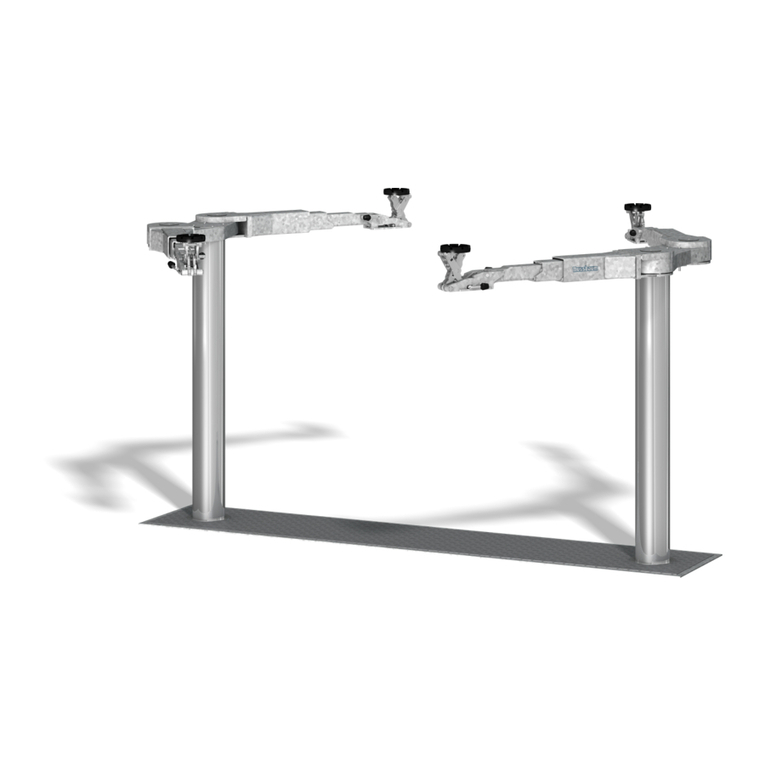
Nussbaum
Nussbaum TSK 8000 Operating manual, Inspection book

Ranger
Ranger RML-1500XL Installation and operation manual

AUSLIFT
AUSLIFT DHE-LG800 instruction manual

TRIUMPH BOARD
TRIUMPH BOARD LiftBox 650 installation manual
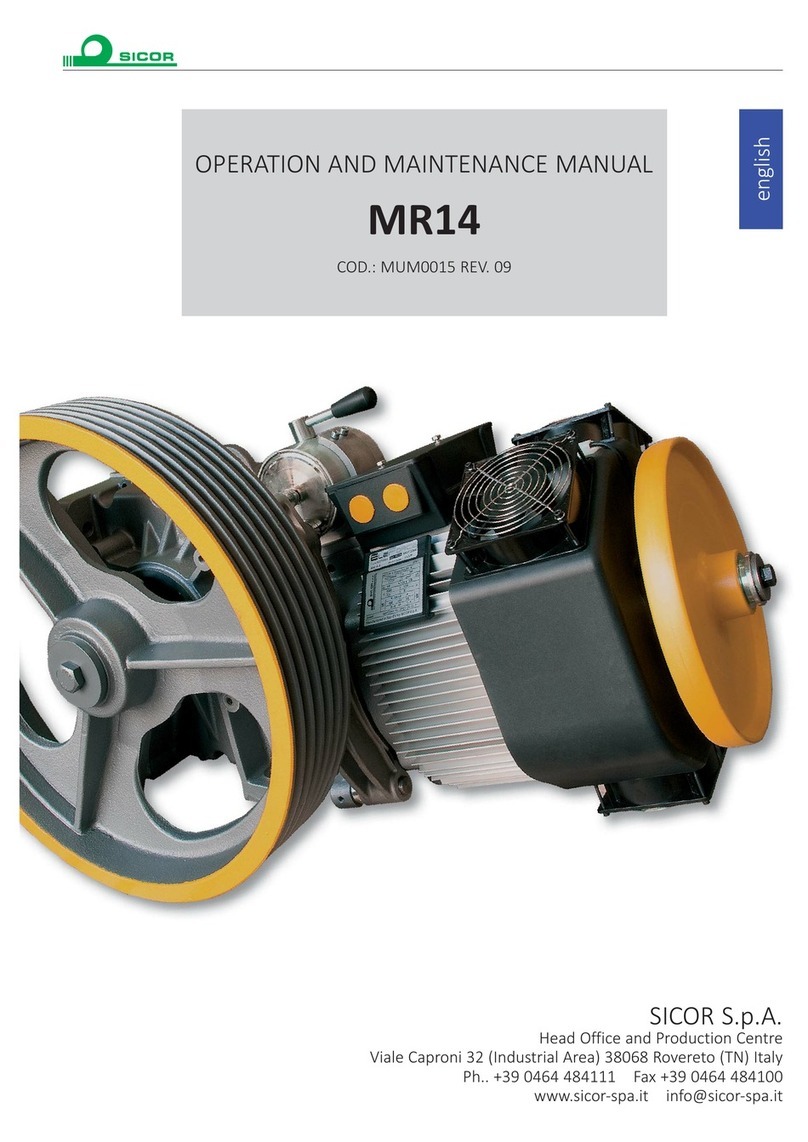
Sicor
Sicor MR14 Operation and maintenance manual

GÜDE
GÜDE GWK 1000 Translation of original operating instructions
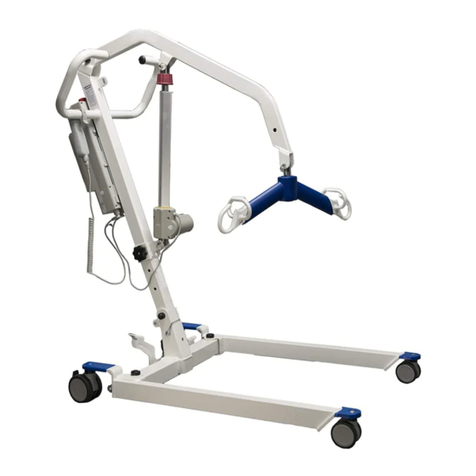
Proactive
Proactive Protekt Take-A-Long 33400P owner's manual
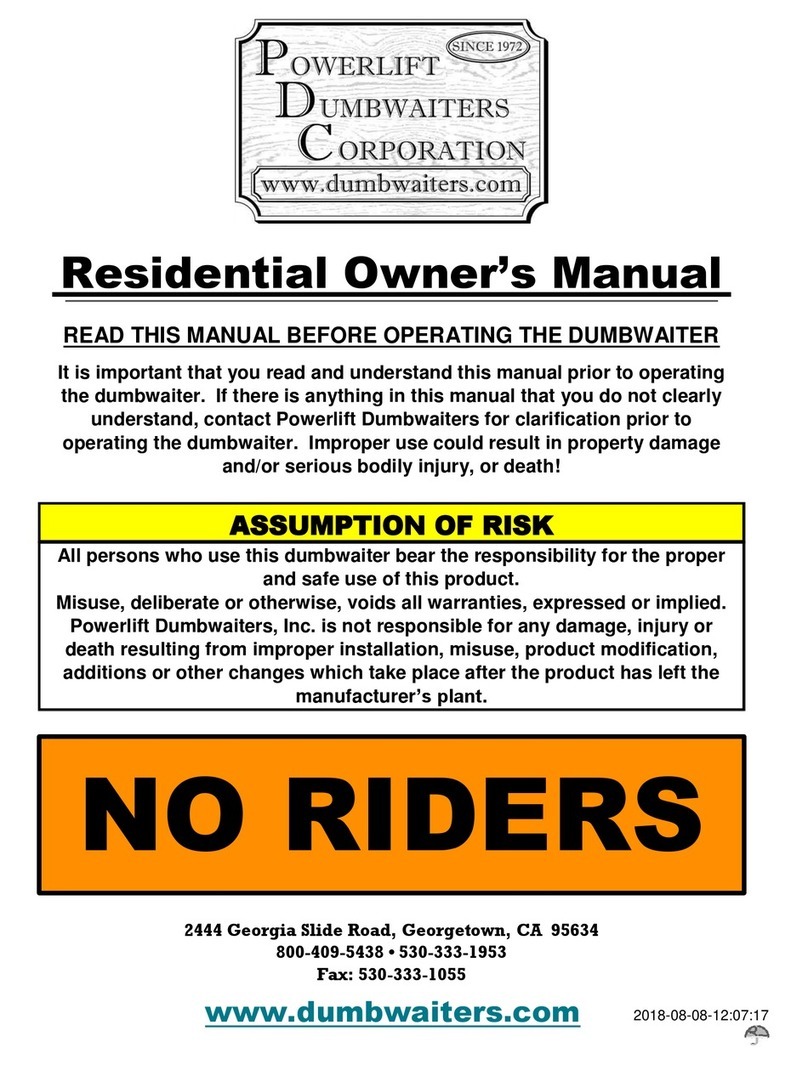
Powerlift Dumbwaiters Corporation
Powerlift Dumbwaiters Corporation P-100 owner's manual
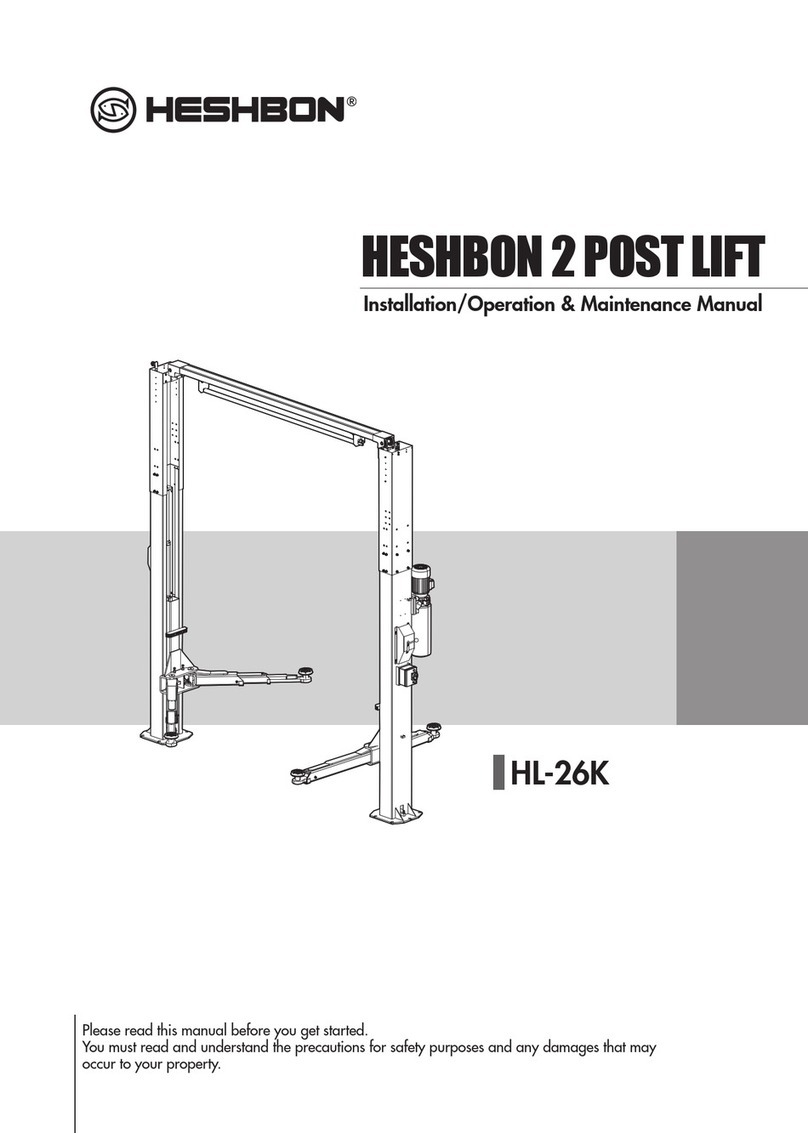
HESHBON
HESHBON HL-26K Installation, operation and maintenance manual

AMGO
AMGO SPL-6 Installation and service manual
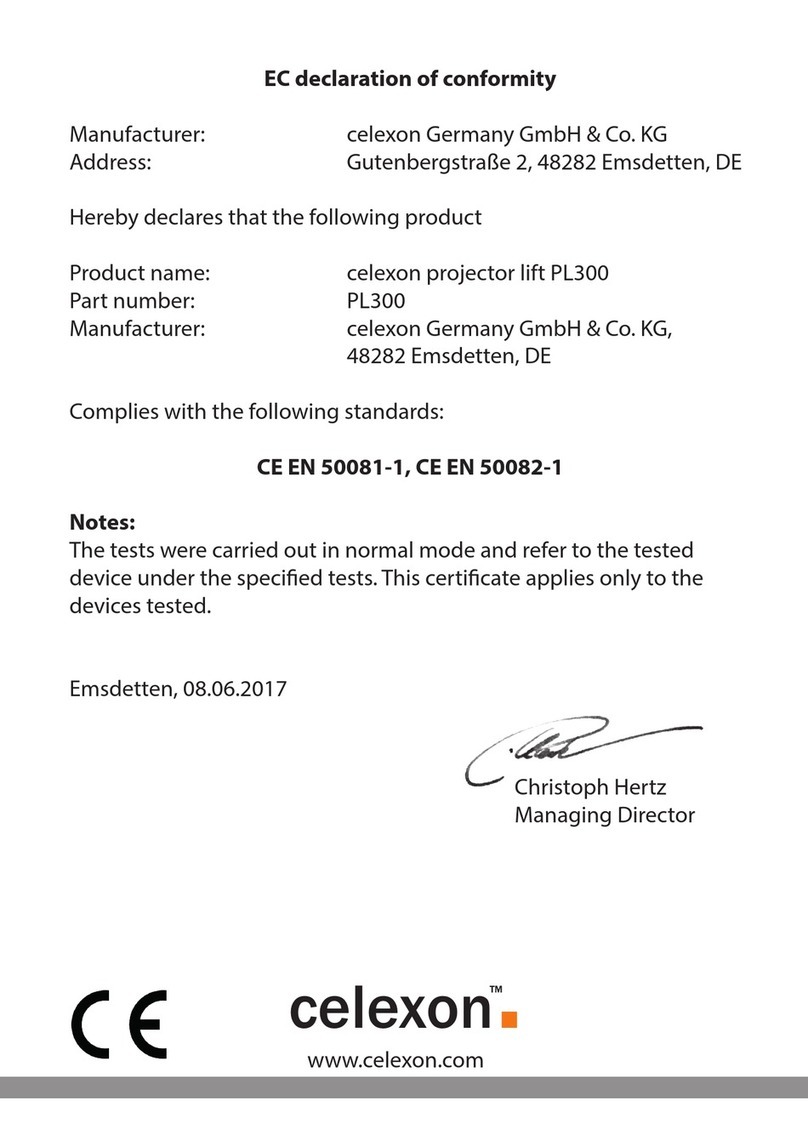
Celexon
Celexon PL300 installation manual
